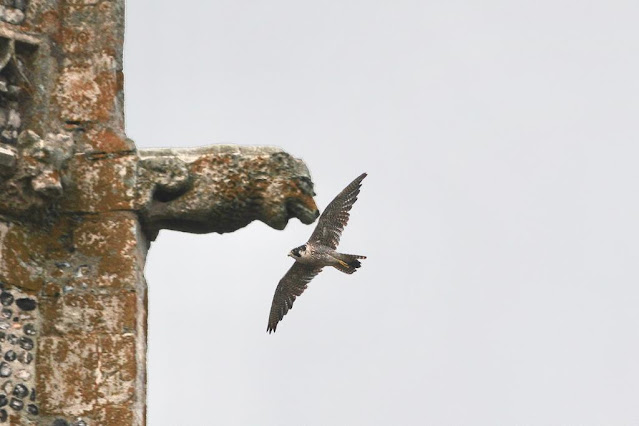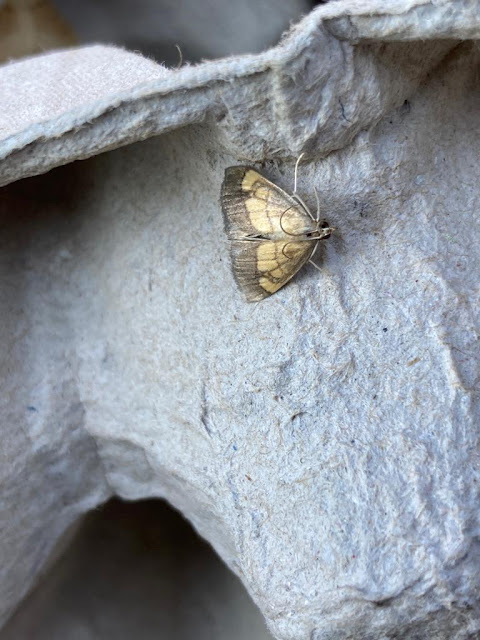Birding on the patch in July generally requires a level of dedication which really "sorts the men out from the boys". So since most of us are well into our second childhoods don't expect a lengthy roundup this month!
One exception to our lethargy was Mick who, due to his role as a volunteer tern warden, was out in the field quite a bit more than most of us. So a lot of the best birds (and insects) this month were down to him spotting them, then alerting the rest of us that it might be worth taking the knotted hankies off our heads, hauling ourselves out of our deckchairs, and struggling along to see his latest find.
This process began on the 1st with a Black Tern on the beach, but at that stage we were all too casual - a party of schoolchildren on an outing scared it off before any of us managed to arrive.
Pat saw another Black Tern during a brief seawatch on the 6th, along with a couple of Manx Shearwaters, which have been rather thin on the ground so far.
On the 8th Mick had an Arctic Tern fly past, and Maynard saw two Spoonbills flying from the Concrete Road in the early morning. There were a couple more Arctic Terns flying around the beach the following evening too, which enabled Sean and Pat to finally connect with them for the year (don't tell anyone, but both of them are too unsure of their tern skills to identify them at anything but very close range 😁).
Returning waders were increasingly in evidence too, with most of us encountering Whimbrel, Curlew, Knot, Dunlin and Bar-tailed Godwits in small numbers on most days.
On the 15th Mick had another Black Tern feeding offshore distantly, and a Great Skua south.
Back in our gardens mothing was happening, and on the 21st Pat caught this unusual micro called a Dark Bordered Pearl. It's a migrant with few records in Norfolk until very recently. Amazingly, Pat had another one four days later on the 25th too. As with many insect species, it seems the heating climate is having an effect on this one's range too.
Red Kites were also around in July, and on the 22nd Barry had 5 in the north dunes, while Mick had 3 at Commissioners Dyke. On the same day Colin finally caught up with Cuckoo at the Double Pool and Mick had a juv at the Coot Pool too.
In the North Dunes there's a nice big patch of bushes which we all know as the Birdless Bushes, since their promise has always exceeded what they deliver. However this year they have been a bit better, with Grasshopper Warbler, Bullfinch and a smattering of other half-decent birds. On the 22nd Sean noted a Willow Warbler in them, and wondered if it was the first returning warbler of the autumn. As he was looking at it another Willow Warbler began calling, but the more he heard this second bird the more it sounded to him like a Redstart! Surely this couldn't be the case, and it was another Willow Warbler - the date was just too wrong. The bird was calling low down in the back of the large clump and just would not show. In desperation Sean recorded the bird on his phone and put it through the notoriously erratic Birdnet app. Here is the result:
However, despite the app's almost certainty, it would be such an unusual record that one can't go on the app alone (which has got some hilariously wrong nocmig results in the past). The bird never appeared and so we can't rule out a slightly odd Willow Warbler... Nevertherless, the Birdless Bushes were back in the game! The following day, in the very same bushes, Barry had a Reed Warbler, Chiffchaff and a pair of copulating Willow Warblers, casting further doubt on the 'Redstart' and also suggesting that far from being a returning migrant Sean's Willow Warbler was more likely to be a late attempting breeder.
On the 25th Mick was returning from a wardening stint on the beach when he discovered this Lunar Hornet Moth walking across Low Road, so several of us took the opportunity to twitch it and Ted arrived to confirm the ID and take the unfortunate moth into care before releasing it in more suitable habitat at Duffles Pond.
On the 26th a large flock of Mediterranean Gulls gathered above the village to hawk insects, and around this time of the month a Hobby could be seen above the village each evening trying to outwit the Swifts.
On the 28th Barry saw a Green Woodpecker in the North Dunes and later that morning Sean saw one and heard up to three, in widely dispersed locations across the North Dunes. You wait ages for a year tick then three come along at once! Was this one bird on the move or some juveniles dispersing? Views were not good enough to tell.
Dragonflies were very active at the end of the month, including some rarities such as Lesser Emperor and Small Red-eyed Damselfly, and this Scarce Chaser which Sean saw near the Holmes Road was possibly a first for Winterton.
Also on the 28th the Birdless Bushes gave even more evidence of their purple patch when Sean flushed an immature Nightjar from their inland edge.
Again on the insect front towards the end of the month there was a mass emergence of Six-spot Burnets in the North Dunes near the village, as well as good numbers of Gatekeepers and steadily increasing Grayling numbers.
Two Green Woodpeckers were also seen by Colin and Mick in the North Dunes on the 30th, and Colin also had another Red Kite over the north woods.
Later on in the afternoon of the 30th, Colin and Gemma both had good views for around five minutes of a bird they are pretty certain was a Black Kite over the North Dunes. This is very interesting because the day before Sean had had a two second glimpse of a bird over the north wood which he immediately thought was a Black Kite, but it disappeared before he could be certain. There were no other reports of a Black Kite in the area but Colin is convinced it was one. On the same day Pat had a Greenshank over his garden, calling, and on the 31st he saw 2 Manx Shearwaters, 2 Arctic Skuas, Redshank, Curlew, Grey Plover, Whimbrel and Turnstone during a morning seawatch in the returning north easterly wind.
At the end of July the total number of bird species which we have collectively seen stands at 182, and we are eagerly looking forward to see what August will bring. Pat, on 162, is pulling away in the yearlist non-competition, but several of us remain within striking distance, and it's not over until it's over. Tim always bides his time, and there's the new boy Maynard, who has already shown what he can do...🙂
Happy patch birding everyone. See you next month!
























0 comments:
Post a Comment